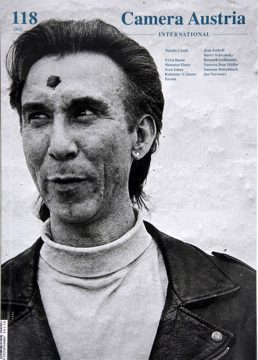Camera Austria
Camera Austria international, no. 118 / 2012
Natalie Czech
Erica Baum
Shannon Ebner
Sven Johne
Editor-in-chief: Maren Lübbke-Tidow
Publisher: Reinhard Braun
ISBN: 9783900508029
The thematic framework of the issue at hand Camera Austria International 118 (2012) “Photography_Text” ensues from the observation that contemporary photographic artists are at present increasingly associating text and image mediums. Forms of superimposition—visually depicting writing with the medium of photography—assume the focal point of various artistic works, for example by Erica Baum, Natalie Czech, and Shannon Ebner: forming a central point of reference here is the genre of Concrete Poetry, a signifier of the disintegration of classical writing forms that fosters a priori a visual-linguistic constellation whereby writing becomes image.
Author Jens Asthoff for instance discovers how Natalie Czech, through her photographs, investigates language as a space of contingency, probes boundaries of meaning, experiments with word-image relations, and encourages stratifications of intertextuality to intersect with and permeate one another. In his literary contribution, Barry Schwabsky poses exploratory questions about Czech’s work—“Is it possible to see her work as one enormous love letter: a billet-doux to poetry?” and notes that the last thing lovers want to give up is the possibility of gazing at the beloved: “Photographing poetry means gazing at it.” After this issue goes to press, Natalie Czech in turn plans to translate parts of her artistic contributions published here into another personal photographic work.
Kenneth Goldsmith, poet and founder of UbuWeb, has already published texts in several of Erica Baum’s artist’s books: both as poet and as theorist. The works of Erica Baum—as those of Czech and Ebner as well—are beholden to the genre of Conceptual Poetry which involves “tactics using uncreativity, unoriginality, illegibility, appropriation, plagiarism, fraud, theft, and falsification as its precepts” (Goldsmith). The point of departure for Baum’s photographic work is her research on antiquarian books (usually) by American poets and on books with unique typographic features or tactile qualities. A further source of her work is categorical keywording in libraries or other text-based archives.
Shannon Ebner likewise explores correlations between image and language, or characters, in her photographs. On the basis of various linguistic patterns, found by the artist in poetry, experimental writing, and political rhetoric, Ebner constructs her photographic textual images, letters, and phrases. Her work analyses the ways in which language and image are mutually dependent and constitutive. Vanessa Joan Müller examines this “ambivalent realm of linguistic representation and optical presence” in the photography of Shannon Ebner, who localises words like sculptures in landscapes and abstract pictorial spaces, develops her own alphabets, or even stages letters as surreally embedded objects trouvés in everyday life.
The ways language/linguistic patterns are used and the functioning principles or manipulability of narration are decisive for understanding the work of Sven Johne: through his serial pieces he fosters complicity between image and writing. Taking reference to the work “Roses from Africa” (2011), Susanne Holschbach writes: “Yet the way in which photograph, caption, and narration are associated, in terms of both content and form, translates the relay function between text and image into an aesthetic configuration that no longer fosters reduction of meaning but rather equivocation on another level.”
The Forum section of this issue has been curated by Mia Jankowicz (Contemporary Image Collective, Cairo) and Constanze Wicke (Museum für Photographie Baunschweig) and shows Cairo-based young artists.









